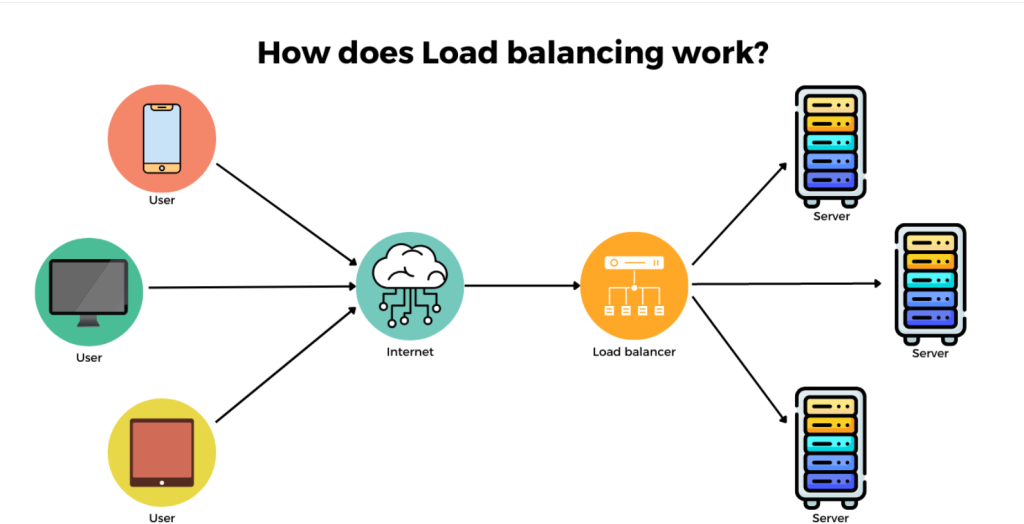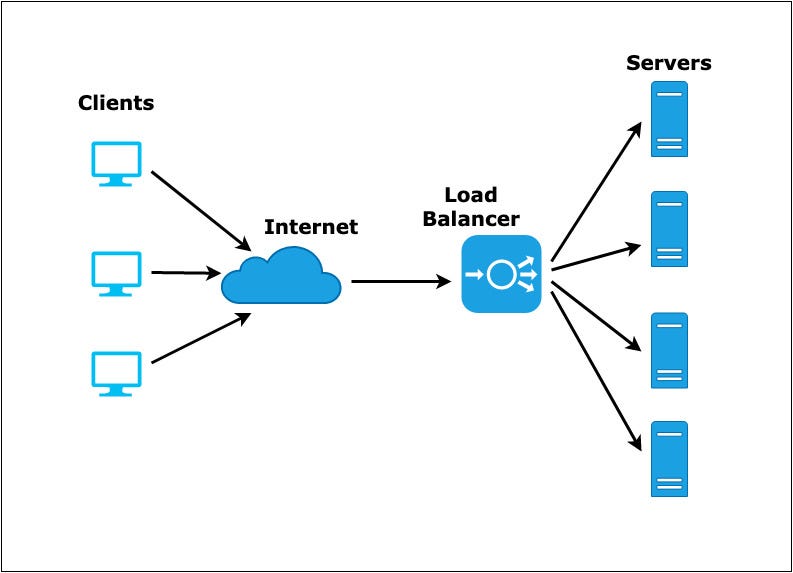In the realm of modern computing, where websites and applications need to serve potentially millions of users simultaneously, ensuring reliability, scalability, and performance is paramount. Load balancers play a crucial role in achieving these objectives. But what exactly is a load balancer? In this blog post, we will explore the fundamentals of load balancing, its types, how it works, and its importance in today’s digital infrastructure.
Table of Contents
Introduction to Load Balancers

A load balancer is a device or software application that distributes network or application traffic across multiple servers. The primary purpose of a load balancer is to ensure that no single server becomes overwhelmed with too much traffic, which can lead to slow performance or even server crashes. By distributing the load evenly, it help optimize resource use, maximize throughput, minimize response time, and ensure high availability.
Load balancers are used in various contexts, including web servers, databases, applications, and networks. They are an integral component of any large-scale, mission-critical IT system.
Types of Load Balancers
It can be categorized based on various criteria, including where they are deployed (hardware vs. software), how they operate (static vs. dynamic), and their layer of operation in the OSI model (layer 4 vs. layer 7).
- Hardware Load Balancers:
- Description: These are physical devices dedicated to load balancing tasks.
- Advantages: High performance, reliability, and specific optimization capabilities.
- Disadvantages: High cost, less flexibility compared to software solutions, and can be harder to scale.
- Software Load Balancers:
- Description: These run on standard servers or virtual machines and perform load balancing functions.
- Advantages: Cost-effective, flexible, easy to scale, and can be easily integrated with cloud environments.
- Disadvantages: Performance can be limited by the underlying hardware.
- Static Load Balancers:
- Description: These distribute traffic based on a predefined set of rules.
- Advantages: Simple to configure and maintain.
- Disadvantages: Can be inefficient if traffic patterns change frequently.
- Dynamic Load Balancers:
- Description: These adjust the distribution of traffic based on real-time analysis of server performance and current load.
- Advantages: More efficient use of resources and better performance.
- Disadvantages: More complex to configure and maintain.
- Layer 4 (L4) Load Balancers:
- Description: Operate at the transport layer (TCP/UDP), making routing decisions based on IP addresses and TCP/UDP ports.
- Advantages: Fast and efficient as they don’t need to inspect the content of the packets.
- Disadvantages: Limited in the types of balancing decisions they can make.
- Layer 7 (L7) Load Balancers:
- Description: Operate at the application layer (HTTP/HTTPS), making routing decisions based on the content of the requests (e.g., URL, HTTP headers, cookies).
- Advantages: More flexibility and capability to make intelligent routing decisions.
- Disadvantages: More resource-intensive due to the need to inspect packet content.
How Load Balancers Work
It use various algorithms to determine the best server to route each request. Here are some common load balancing algorithms:

- Round Robin:
- Description: Distributes requests sequentially across all servers in the pool.
- Advantages: Simple and easy to implement.
- Disadvantages: Doesn’t account for server load or capacity differences.
- Least Connections:
- Description: Routes traffic to the server with the fewest active connections.
- Advantages: Balances load more effectively, especially in environments with long-lived connections.
- Disadvantages: Can become less efficient if some servers are more capable than others.
- IP Hash:
- Description: Uses the client’s IP address to determine which server will handle the request.
- Advantages: Ensures that a client will consistently connect to the same server, useful for session persistence.
- Disadvantages: Can lead to uneven distribution if the number of clients is small or not well-distributed.
- Least Response Time:
- Description: Sends traffic to the server with the lowest response time.
- Advantages: Aims to provide the best user experience by minimizing latency.
- Disadvantages: Requires constant monitoring of server performance, which can add overhead.
- Weighted Round Robin:
- Description: Similar to round-robin but assigns weights to each server based on their capacity. Servers with higher weights receive more requests.
- Advantages: Better handles servers with different capabilities.
- Disadvantages: Requires accurate capacity measurement and configuration.
- Random:
- Description: Distributes requests to random servers.
- Advantages: Simple and can work well in homogeneous environments.
- Disadvantages: Can lead to uneven load distribution.
Importance of Load Balancers
Load balancers are crucial for several reasons:

- Improved Performance:
- By distributing requests across multiple servers, load balancers help ensure that no single server becomes a bottleneck. This results in faster response times and better overall performance.
- High Availability and Reliability:
- It can detect server failures and automatically reroute traffic to healthy servers, ensuring continuous service availability. This failover capability is essential for maintaining reliability in high-traffic environments.
- Scalability:
- It make it easier to add or remove servers from your pool, allowing you to scale your infrastructure up or down based on demand. This scalability is critical for handling varying traffic loads and growth.
- Security:
- By acting as a gateway between clients and servers, it can provide an additional layer of security. They can protect against Distributed Denial of Service (DDoS) attacks by absorbing and distributing malicious traffic across multiple servers.
- Resource Utilization:
- Efficient load distribution ensures that all servers are used optimally, avoiding scenarios where some servers are idle while others are overloaded.
- Session Persistence:
- It can maintain session persistence, also known as “sticky sessions,” ensuring that a user’s requests are consistently directed to the same server. This is crucial for applications where user state must be maintained across multiple requests.
Real-World Applications of Load Balancers
Load balancers are employed across various industries and use cases. Here are a few examples:

- E-commerce Websites:
- During peak shopping periods, e-commerce platforms experience significant traffic spikes. it ensure that the website remains responsive and transactions are processed smoothly.
- Content Delivery Networks (CDNs):
- CDNs use load balancers to distribute requests for content (such as images, videos, and files) across multiple edge servers. This ensures fast content delivery and reduces the load on the origin servers.
- Financial Services:
- Banks and financial institutions use load balancers to manage high volumes of transactions and ensure that their online services remain available and secure.
- Healthcare Systems:
- In healthcare, where timely access to information is critical, load balancers ensure that electronic health records (EHR) systems and telemedicine applications are reliable and perform well under load.
- Cloud Services:
- Cloud providers like AWS, Google Cloud, and Azure offer load balancing as a service, allowing businesses to deploy scalable and resilient applications in the cloud.
Challenges and Considerations
While load balancers provide numerous benefits, they also come with certain challenges and considerations:
- Configuration and Management:
- Properly configuring and managing load balancers can be complex, especially in large-scale environments. It requires careful planning and continuous monitoring.
- Latency:
- It introduce an additional layer in the network path, which can add some latency. However, this is typically minimal and outweighed by the performance benefits.
- Cost:
- Hardware load balancers can be expensive, and even software load balancers come with costs associated with licensing, management, and infrastructure.
- Security:
- While load balancers can enhance security, they must be properly configured to avoid becoming a single point of failure or a target for attacks. Ensuring robust security measures is essential.
- Complexity in Dynamic Environments:
- In environments with constantly changing traffic patterns and server states, dynamic load balancing can become complex and require sophisticated algorithms and real-time monitoring.
Future of Load Balancing
The future of load balancing is likely to be shaped by several trends and technological advancements:

- AI and Machine Learning:
- The integration of AI and machine learning in load balancing algorithms can lead to more intelligent and adaptive traffic distribution, optimizing performance and resource utilization in real-time.
- Edge Computing:
- As edge computing becomes more prevalent, load balancers will need to operate closer to the edge, managing traffic distribution across a dispersed network of edge servers.
- Cloud-Native Architectures:
- The rise of microservices and containerization is driving the need for load balancers that can efficiently manage traffic between microservices, both within and across cloud environments.
- Security Enhancements:
- It will continue to evolve to provide more advanced security features, protecting against increasingly sophisticated cyber threats.
- Serverless Computing:
- In serverless architectures, load balancing will adapt to handle functions and ephemeral instances, ensuring efficient distribution of stateless workloads.
Conclusion
It’s a fundamental component of modern IT infrastructure, enabling organizations to build scalable, reliable, and high-performance applications. By distributing traffic across multiple servers, they ensure optimal resource utilization, high availability, and improved user experiences. As technology continues to evolve, so will load balancers, incorporating advanced algorithms and adapting to new architectural paradigms. Understanding and implementing effective load balancing strategies is crucial for any organization looking to thrive in today’s digital landscape.

